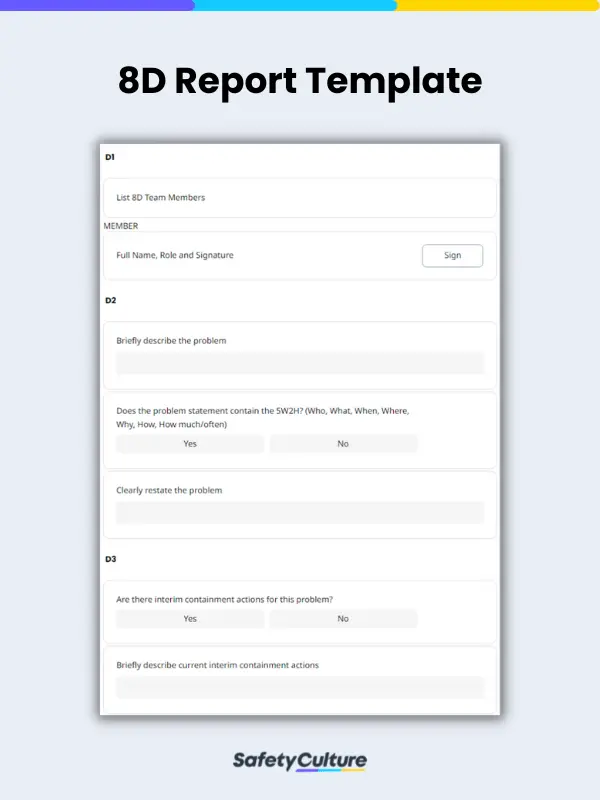What is 8D?
8D refers to the Eight Disciplines Model which is a problem-solving technique used to contain, resolve, or prevent issues identified in a product or process by quality engineers. The 8D model was initially used in the automotive industry due to Ford’s influence, but it is now widely used in a variety of industries, including manufacturing, healthcare, and retail, with great success.
What is an 8D Report?
An 8D Report is a comprehensive method that aims to eliminate problems by identifying and attacking their root cause(s). 8D Reports can lead to preventive measures that resolve persistent issues by utilizing a combination of expertise, data analysis, management tools, and data validation.
8D Format: The 8 Disciplines
The format of an 8D template encompasses the eight disciplines of problem-solving which are:
- D1: Form a team
- D2: Define the problem
- D3: Develop a containment plan
- D4: Identify root cause and escape points
- D5: Formulate corrective actions
- D6: Implement corrective actions
- D7: Formulate preventive measures
- D8: Congratulate the team
8D Report Pros and Cons
8D report templates have helped countless businesses improve their operations with its thorough, structured approach to problem solving. However, it has prerequisites that may not appeal to smaller operations with limited resources.
8D Report Pros
8D Reports provide a long-term solution.
The 8D Model aims to eradicate the problem, not its symptoms. Once a problem has been identified, 8D takes a three-pronged approach to solving it.
- Containment
The goal of a containment measure is to minimize the potential damage that can be dealt by an identified issue while a permanent, long-term solution is being formulated. In the context of manufacturing, something as simple as halting production due to a faulty machine can limit the consequences of the problem. - Resolution
Once damage control is successful, the focus shifts to creating a long-term solution. This is where the 8D Team, composed of experts in different facets of the business problem, brainstorm to come up with the most sensible and sustainable solution(s) to the issue. - Prevention
After effectively resolving the issue, the final step is ensuring that it doesn’t happen again. Examples of preventive measures include updating policies, introducing new SOPs, or improving quality-control standards. Using a digital checklist to perform quality and process audits will help ensure that the changes made are consistently being implemented so the issue doesn’t recur.
8D Reports address the escape point.
An “escape point” refers to the first control point in the system or process which was supposed to detect the problem, but failed. The study of escape points in an 8D form helps teams find the flaws in safety measures and fail-safes so they can be improved. How well the team identifies and rectifies the escape point is crucial to their successful use of the 8D model.
8D Reports are flexible.
The 8D Report Model has seen extensive use outside of the auto industry. Hardware manufacturing, food manufacturing, and healthcare are just a few of the many industries that have benefited from using the 8D Report Model. Here is an example of an 8D PDF used in a hospital setting.
8D Report Cons
Extensive training is needed to use it effectively.
Effective use of the 8D Model requires knowledge of the problem-solving process, as well as various data-collection and analysis tools.
An 8D training program can be tedious to develop and conduct. A dedicated budget is also required if you plan to have your team take a pre-made 8D training course.
FAQs about 8D and 8D Reports
To write an 8D report, the 8 disciplines of problem solving should be followed:
- D1 – Create a team
- D2 – Describe the problem
- D3 – Develop an interim containment plan
- D4 – Determine, Identify, and verify root cause of the problem
- D5 – Determine permanent corrective actions to solve the problem(s)
- D6 – Implement and validate corrective actions
- D7 – Take note of other additional measures to prevent recurrence of the same problem(s)
- D8 – Determine how the team can be rewarded for their efforts and to boost motivation
The 8D process usually takes four days, but may prolong depending on the complexity of the problem. At max, it is expected that 8Ds will be closed in less than 30 days.
The 8D methodology and 8D reports are triggered by a complaint, especially if these complaints relate to safety or regulatory issues, high-volume customer complaints, warranty costs, internal rejects, poor performance, etc. In some cases, 8D is used as a standard procedure as a component of quality management.



